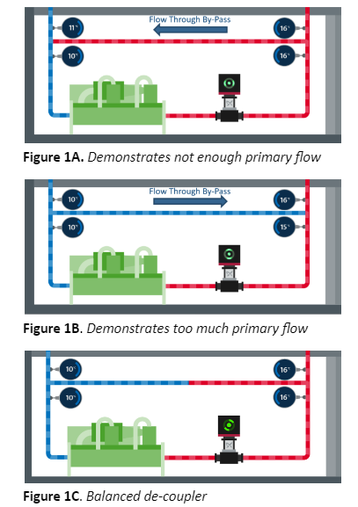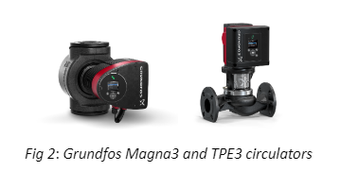In a typical chilled water hydronic system, fluid is moved through the piping network by pumps and controlled by a series of balancing and control valves.
The most common arrangement for pumps is constant primary with variable secondary or a variable primary arrangement. Here, the balancing and control valves are located throughout the pipe network and used to control flow to the zones.
Grundfos’ distributed pumping design eliminates the need for control valves at each zone by adding smart circulating pumps in their place. By adding pumps, we eliminate flow-inhibiting valves that increase pressure loss in the system.
Instead, these are replaced with flow-initiating devices (pumps), reducing the friction loss in the system, resulting in reduced energy consumption in the system.
Distributed pumping is more than just replacing valves with pumps. It is a new way of regulating and balancing the entire chilled water system utilizing pump specific functionality to control the system. This is key to the flow control and overall reduction of energy consumption in the system.
Controlling the dynamic of the de-coupler
In a distributed pumping system, the primary pumps are not only trying to satisfy the system set point, they are actually balancing the flows across the de-coupler.
By using Grundfos’ dedicated controller, the system first ensures the chillers’ minimum flow is satisfied. This protects the chiller, and once the chillers are satisfied, the controller will focus on the temperatures across the de-coupler.
Temperature sensors should be installed before and after the de-coupler on both the supply and return lines. The goal is to be flow-neutral throughout the de-coupler. The delta T on the primary side should match the delta T on the secondary side. If both do not match, it means there is flow in either direction through the de-coupler.
To eliminate this, the controller should increase or decrease the speed of the primary pumps depending on the temperature difference. At the same time, the minimum flow through the chiller should still be maintained. The goal is to avoid flow in the decoupling line. See Figures 1A, 1B, and 1C.
Controlling the distributed pumps
In a distributed pumping network, the primary and distributed pumps work independently of their individual control sequencing.
The primary pumps’ controller is focused on the primary pumps’ flow out to the de-coupler while the distributed pumps’ (or zone pumps’) built-in controllers only control the flow of their specific zone. The primary and distributed pumps require different types of controls and sequencing.
How is the distributed pumping system balanced if there are no balancing valves?
The pumps auto-balance the system. All that is required during commissioning is to set the maximum pump flow for each of the distributed pumps based on the maximum flow for the CRAW/zone being serviced.
Doing this ensures the system never runs out of balance and will not need rebalancing after years of operation. The pumps will continuously readjust to any system changes ensuring optimal operation throughout the entire lifetime of the equipment.
What kind of pumps are used as distributed pumps?
Smart circulators (see Figure 2) are the ideal choice for distributed pumps. They incorporate a pump, motor, variable speed drive and sensors in a single unit.
Adding intelligence is what separates smart pumps from standard pumps. Smart pumps have onboard control logics that perform different operations – from flow control, proportional pressure, and automatic adaptation to the system’s requirements.
The smart pumps logic is key to a distributed chilled water system. The most important are the Flow Estimation and Flow Limit functions that are based on readings from the built-in differential pressure sensor.
With Flow Limit, the Grundfos pump will only increase the pump flow up to the maximum design flow set in the pump. It maintains the set point by varying the speed of the pump/motor.
By setting the flow limit of the distributed pumps, the system is practically balanced. This is key to preventing over-pumping of the system, which can cause it to operate at a lower efficiency due to inadequate energy transfer in the zone coil.
How can balancing and control valves be substituted with a pump?
When using balancing and control valves in a chilled water system, they are either set manually and/or automatically adjusted using signal inputs from the building management system (BMS).
The condition requirements of the system dictate the signals controlling the position of the control valve. When changing the valves to a pump, the same input from the BMS can be used to control the pump. The onboard logic can also be used in conjunction with an input signal.
What additional input is needed to size a distributed pumping system?
Because distributed pumping delves further into overall system design, more information is needed than for traditional pump selections.
Grundfos takes the schematic layouts, equipment schedules, pipe and fitting details and other design information and redesigns the system as a distributed pumping system.
Grundfos delivers a complete design package including revised pipe and fitting sizing, and an energy savings calculation comparing the distributed pumping design with the traditional system design.
Conclusion
Removing the valves in a chilled water system not only improves overall efficiency – the actual implementation is easy to do with Grundfos distributed pumping.
Since distributed pumps can function on their own, the BMS becomes less critical to the overall operation of the system. This is also true when it comes to controlling the primary pumps locally with a built-in Grundfos controller. The result is a system that is better balanced and more efficient.


